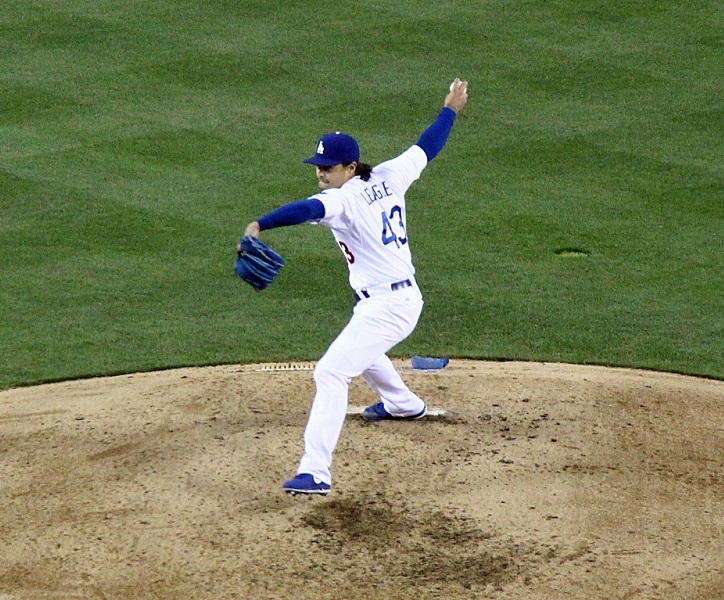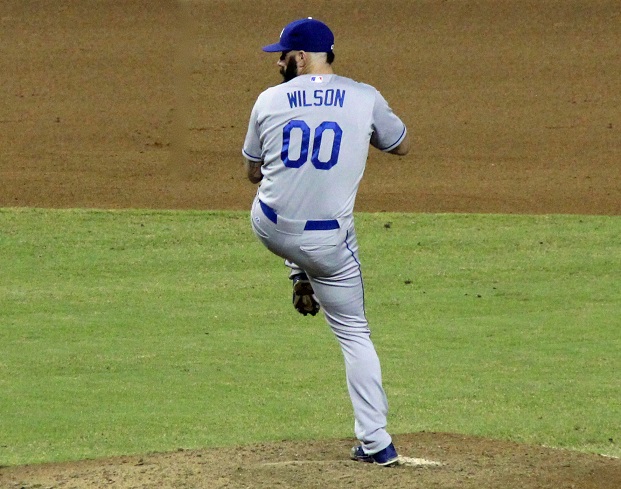Over a week ago during one of his daily pre-game media briefings, Dodgers manager Don Mattingly was asked “Are you concerned about the struggles in the bullpen?”
To the surprise of the gathered media, Mattingly asked “What struggles?”
After pointing out the excessive number of walks that his bullpen has allowed, Mattingly finally admitted that he and pitching coach Rick Honeycutt were aware of the high number of walks and that they were “talking about it.”

Brandon League is living proof that a struggling pitcher can turn things around significantly. League has become one of the most reliable relievers in the Dodgers bullpen this season.
(Photo credit – Ron Cervenka)
Fast forward to Monday night’s pre-game media briefing when Mattingly was asked specifically “With the Dodgers leading the National League in bullpen walks with 74 (which is now 75), is there anything that you can do about that?”
Unlike last time, Mattingly recognized (or at least acknowledged) that the excessive number of bullpen walks was a real, tangible thing and not the figment of some beat writer’s imagination.
“We’re going to continue to work, obviously” Mattingly said. “We were looking at bullpen stuff today actually, all the ratings and those areas. Rick [Honeycutt] had kind of brought it up a couple of weeks ago the number of guys we were walking.”
How is it possible that, in a time where every baseball statistic imaginable is only a mouse click away, a major league baseball manager can go a month and a half into the new season and only now become aware that his bullpen is the worst in the league in walks and first in the league in bullpen losses – especially after his bullpen struggles were pointed out to him by the media?
Here’s what Mattingly had to say about that:
“At first you don’t really notice it and then it becomes clearer and clearer,” explained the Dodgers skipper. “I think it’s something that we continue to work on. Ya, I think there’s something that you can do about it – we can continue to work on where our attack plan is, where our thinking is, just making sure that we’re thinking properly and what we’re trying to do. I think all of our guys are capable of throwing strikes, I think we’re going to get better but I think we just keep working towards that.”
This has got to be one of Mattingly’s best ‘non-answers’ and it doesn’t really address the problem – better command and control of the strike zone under pressure, reducing the number of walks (especially lead off walks), reducing the number of hit batsmen (at which Dodger relievers are tied for first in the MLB with nine), reducing the number of wild pitches and simply pitching better.
Now granted, there isn’t a magic pill or secret formula to suddenly make these things happen, but perhaps a little butt-chewing or better yet, a little reminder that there are thousands of kids in the minors who would gladly take their jobs from them if they don’t improve might get the message across to them.

There is no kind way to put it – Brian Wilson is hurting the Dodgers far more than he is helping them and it’s time for the Dodgers to cut their losses and get rid of him in spite of his large contract.
(Photo credit – Ron Cervenka)
To his credit, Mattingly strongly supports his players and said that he prefers sending his relievers right back out there after a rough outing rather than giving them a break to try to regroup – particularly his closer.
“If it’s a save situation I’d rather get him right back out there,” said Mattingly.
As for the rest of his relievers, he feels basically the same way.
“I think they want to get right back out there, they don’t want to sit around and think about it,” Mattingly said. “The bad thing about a starting pitcher is that if you have a rough outing you gotta wait four days to be able to go back out there. The best thing about being an everyday player is that if you don’t get a hit one day you can go back out there the next day and have a chance to contribute and you don’t have to wait around and let it kind of stew. I like to be able to get [them] right back out there as soon as possible.”
Okay, this is a much better answer and better explains Mattingly’s frame of mind and thought process, but it still doesn’t explain him missing the obvious – that his bullpen is among the worst in the league (or MLB) in walks, losses, hit batsmen and wild pitches, all of which absolutely must be improved upon for the Dodgers to have any chance of returning to the postseason. It also clearly shows that ignoring these struggles doesn’t work.




 May 14th, 2014 at 6:00 am
May 14th, 2014 at 6:00 am  by Ron Cervenka
by Ron Cervenka  Posted in
Posted in 

Yes those walks really killed us. They’ll have to start throwing strikes more often because many of these batters on some of these teams never swing at anything that misses the strike zone. I notice batter coming up to the plate in the late innings are showing a lot of plate discipline and are only swinging at pitches they can do damage with. It’s amazing how well they know the strike zone. So it’s time for our relievers to counter this by pitching more to contact.
At least that’s the way I see it.
A very good point, Joe.
When you see guys like Withrow and Jansen (who normally have exceptional command and control) walk guys, it is because they are nibbling – which on some hitters you absolutely have to do, but not on all of them. You can still pitch to contact without throwing a cookie right down the middle.
It seems that most (if not all) of the Dodgers relievers think that they have to strike everybody out, which would be nice but is not essential (nor possible). They can just as easily pitch to contact (so long as they keep them in the park) and let their defense make the outs.
I agree, that’s what I’ve been trying to say. They should stop nibbling. Many of these pitches are just slightly out of the strike zone and many of these hitters that our relievers have been facing seem to be very selective and discipline and stay off these pitches no matter how close they are to being strikes(unlike what seems to be most Dodger hitters) and are successful in producing walks.
In many cases, as you say, it’s better for the relievers to throw strikes.